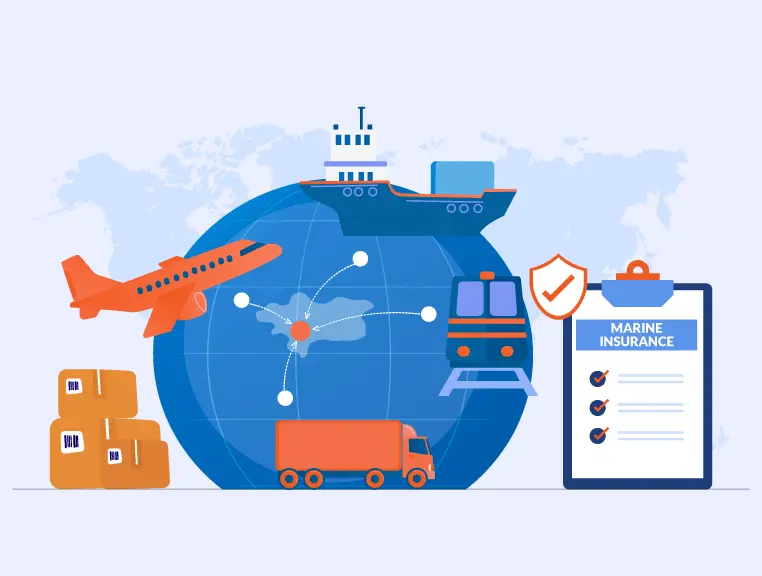Logistics systems are an important part of the shipping business. Be it a small business or a reputed logistics company involved in the shipping of cargo, freight transportation models or strategy is an important component. When we talk about freight transportation models, intermodal transportation and multimodal transportation are the two most commonly heard terms. In this article, let us explore the intermodal transport meaning, its advantages, and the key differences between intermodal and multimodal transportation.
Define intermodal transportation
Intermodal transportation refers to a logistics system of transporting goods from one place to another using various modes of transportation within a single journey. The modes of transportation include rail, road, air, and waterways. In a single journey, each leg of the shipment requires a separate transport carrier and an independent contract.
It involves the use of standardized containers or cargo units that can be easily transferred between different modes of transport without the need to unload and reload the goods themselves. Intermodal logistics is a cost-effective and efficient way to move freight. Along with employing the strengths of various modes of transport, it reduces the delays and limitations associated with depending solely on one mode of transportation.
Benefits of intermodal transportation
Intermodal transportation offers various benefits in the shipping industry. Here are the advantages offered by the intermodal transportation:
-
Cost efficiency
Intermodal transportation makes optimal utilization of various modes of transportation and saves labor, fuel, and other costs associated with single-mode transportation for shipping and logistics companies. Hence, intermodal transportation can be a cost-efficient option.
-
Reduces transit delays
Intermodal transit can reduce transit delays by combining slower and cost-effective modes of transport like waterways or railways with faster modes of transport such as air freight.
-
Eco friendly
With optimal utilization of eco-friendly transport modes like sea or rail instead of road transport, intermodal logistics can contribute to environmental safety.
-
Flexible
As different legs of the journey have separate transport carriers and transport modes, companies shipping the cargo can make choices based on their need, accessibility, and affordability.
-
Reduced risk
Instead of relying solely on a single mode of transport, the intermodal transportation system relies on multiple modes for a single journey. Hence, if there are issues with one mode of transport, cargo can be shipped using another convenient mode of transport. This reduces the risk associated with the logistics.
-
Enhanced security
Intermodal transportation system follows standardized containers that enhance the safety of goods shipping. This ensures reduced need for frequent loading and unloading of goods and also easy transfer from one mode of transport to another.
The shipping industry also uses a multimodal transportation system for moving goods from one place to another. Both models are effective and cost-efficient. However, the concept is different from that of intermodal transportation. Multimodal transportation integrates different modes of transportation within the supply chain using a single carrier for a single journey. That means, there is a single contract for all legs of shipment and the same carrier is responsible for moving the freight from one leg to another. Let us take a look at some key differences between both intermodal and multimodal transportation.
The difference between intermodal transportation and multimodal transportation
| Intermodal transportation | Multimodal transportation |
| Uses various modes of transportation effectively within a single journey. Each leg of the shipment in this single journey has a separate transport carrier and an independent contract. | Uses multiple modes of transport within a supply chain but might not necessarily entail the seamless transfer of containers or cargo units between modes. |
| Easy transfer of goods and no need for loading and unloading of goods at various journey points. | Might require frequent loading and unloading of freight at each journey point of shipment. |
| Seamless transfer of goods by following standardized containers ensures reduced risk and enables a more efficient journey. | Multimodal transportation focuses on integrating different modes of transport to optimize the overall logistics chain and achieve cost-efficiency and timeliness |
Conclusion
To sum up, understanding the freight transportation models can help you know the advantages, disadvantages, and challenges involved. This can help shipping companies to make a suitable freight transportation mode as per business needs.
About The Author
Simran
MBA Insurance and Risk
With extensive experience in the insurance industry, Simran is a seasoned writer specializing in articles on marine insurance for SecureNow. Drawing from 5 years of expertise in the field, she possesses a comprehensive understanding of the complexities and nuances of marine insurance policies. Her articles offer valuable insights into various aspects of marine insurance, including cargo protection, hull insurance, and liability coverage for marine-related risks. Renowned for their insightful analysis and informative content, Simran is committed to providing readers with actionable information that helps them navigate the intricacies of marine insurance with confidence.




